Video editing is an essential skill in today’s digital age, used by professionals and amateurs alike for content creation, filmmaking, vlogging, marketing, and social media. Whether you’re crafting a professional film or simply putting together a family video, understanding the basics of video editing can significantly enhance the quality of your final product.
In this article, we’ll cover the fundamentals of video editing, popular software options, techniques, and tips to help you get started or elevate your editing skills.
What Is Video Editing?
Video editing is the process of manipulating and rearranging video clips to create a finished product. This can include trimming unwanted footage, adjusting audio, adding effects, transitions, titles, and more. The goal is to make the content visually appealing and engaging while conveying the desired message.
The Video Editing Process: Step-by-Step
Understanding the editing process is key to mastering video editing. Below are the main stages involved:
1. Pre-Production (Planning)
Before editing begins, you need to plan your project. This involves:
- Organizing footage
- Understanding the structure of the video
- Scripting (if necessary)
- Deciding on visual styles, music, and special effects
2. Importing Footage
Import the video files, audio, and other media into your video editing software. Most editors allow you to organize your clips into bins or folders to keep everything in order.
3. Cutting and Trimming
In this stage, you remove unwanted footage, trim clips, and begin to arrange your shots in the correct order. Editing involves both:
- Cutting: Removing parts of the video.
- Trimming: Shortening a clip from its start or end.
4. Audio Editing
Good audio is just as important as good visuals. During this stage:
- Sync the audio with video
- Adjust audio levels
- Add background music or sound effects
- Remove noise or enhance dialogue clarity
5. Adding Visual Effects and Transitions
To make your video more dynamic, you can use effects like color grading, overlays, and transitions between scenes.
- Transitions: Smooth transitions between clips, such as fades, wipes, and dissolves.
- Effects: Special effects, such as slow motion, zooms, or animation.
6. Titles and Graphics
Titles are crucial for introducing the video, crediting people, or providing additional information. Graphics like lower thirds or captions can also be added here.
7. Color Grading
Color grading is the process of adjusting the colors in your video to achieve the desired look. This can range from making the video appear warmer or cooler to creating stylized effects like vintage looks or cinematic tones.
8. Exporting and Rendering
Once the video is complete, it must be exported in a format suitable for the intended platform. Whether it’s for YouTube, social media, or a film festival, each platform has recommended settings.
Popular Video Editing Software
Choosing the right software depends on your needs, skill level, and budget. Below are some popular video editing tools:
1. Adobe Premiere Pro
- Best For: Professionals and advanced editors
- Features: Powerful editing tools, color grading, audio editing, and integration with other Adobe apps.
- Platform: Windows, macOS
- Cost: Subscription-based
2. Final Cut Pro
- Best For: Professional macOS users
- Features: Magnetic timeline, advanced color grading, and 360° video editing.
- Platform: macOS
- Cost: One-time purchase
3. DaVinci Resolve
- Best For: Color grading and advanced editing
- Features: Offers both free and paid versions with excellent color correction tools.
- Platform: Windows, macOS, Linux
- Cost: Free (paid version available)
4. iMovie
- Best For: Beginners and casual users
- Features: Simple drag-and-drop interface, basic editing tools, and effects.
- Platform: macOS, iOS
- Cost: Free
5. Filmora
- Best For: Beginners and YouTubers
- Features: Intuitive interface, built-in music, transitions, and special effects.
- Platform: Windows, macOS
- Cost: Subscription or one-time purchase
Key Video Editing Techniques
To make your video stand out, here are a few essential editing techniques:
1. Jump Cuts
A jump cut is a technique where you cut out sections of a video to make it faster and more engaging. It’s commonly used in vlogs and YouTube content.
2. Match Cuts
A match cut is a transition where one shot visually or thematically matches the next shot. This can create a smooth, artistic flow from one scene to another.
3. Slow Motion and Time Lapse
Slow motion can emphasize moments and add drama, while time-lapse condenses long scenes into seconds or minutes, often used to showcase changing landscapes or processes.
4. Split Screen
A split screen allows you to show multiple perspectives at the same time, often used for comparison or showing simultaneous actions.
5. Chroma Key (Green Screen)
This technique allows you to remove a specific color (usually green) and replace it with another image or background. This is often used in special effects, such as weather reports or movie scenes.
Tips for Effective Video Editing
To help you create better videos, here are some tips to keep in mind:
1. Keep It Concise
People have short attention spans. Make sure your video delivers its message efficiently, without unnecessary filler.
2. Focus on Storytelling
Whether your video is a tutorial, vlog, or documentary, always keep the story in mind. A strong narrative keeps viewers engaged.
3. Use Music Wisely
Background music can set the tone for your video. Use music that complements the mood but avoid making it too loud or overpowering.
4. Maintain Consistency
Use consistent colors, fonts, and transitions throughout your video to create a professional and polished look.
5. Export in the Right Format
Different platforms have specific video format requirements. Ensure your export settings are optimized for where the video will be displayed (e.g., YouTube, Instagram, etc.).
Conclusion
Video editing is a powerful tool that can take your content to the next level, whether you’re a beginner or an experienced editor. By understanding the video editing process, exploring the right software, applying key techniques, and following helpful tips, you can create videos that are not only visually appealing but also tell a compelling story.
